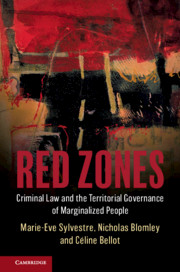Book contents
- Red Zones
- Red Zones
- Copyright page
- Dedication
- Contents
- Figures
- Maps
- Tables
- Acknowledgments
- Cases
- Legislation
- 1 Navigating the Territories of the Law
- Part I Foundations
- 2 Law and Territory: A Legal Geography
- 3 “Recognizances to Keep the Peace and Be of Good Behaviour”: The Legal History of Red Zones and Conditions of Release
- Part II Expansion
- Part III Territorialization and Its Consequences
- Conclusion
- Bibliography
- Index
2 - Law and Territory: A Legal Geography
from Part I - Foundations
Published online by Cambridge University Press: 06 February 2020
- Red Zones
- Red Zones
- Copyright page
- Dedication
- Contents
- Figures
- Maps
- Tables
- Acknowledgments
- Cases
- Legislation
- 1 Navigating the Territories of the Law
- Part I Foundations
- 2 Law and Territory: A Legal Geography
- 3 “Recognizances to Keep the Peace and Be of Good Behaviour”: The Legal History of Red Zones and Conditions of Release
- Part II Expansion
- Part III Territorialization and Its Consequences
- Conclusion
- Bibliography
- Index
Summary
Chapter 2 establishes the theoretical and conceptual grounds on which the study lies, arguing that we can usefully conceive of spatial conditions of release through the lens of critical legal geography, emphasizing the work of law in producing powerful spatiotemporal arrangements and representations that act upon the social world. Spatial conditions of release are as a form of legal territorialisation, or a strategic attempt at structuring socio-legal relations through the configuring of space and time. By territorializing a set of legal commands, legal actors aim to communicate, classify, enforce, and legitimize. Focusing on the practical work of spatial conditions of release directs us to the work they do in organizing socio-legal relations. In particular, the authors note the complex and simultaneous relational work of “cutting” and “joining” they entail.
Keywords
- Type
- Chapter
- Information
- Red ZonesCriminal Law and the Territorial Governance of Marginalized People, pp. 23 - 37Publisher: Cambridge University PressPrint publication year: 2020

